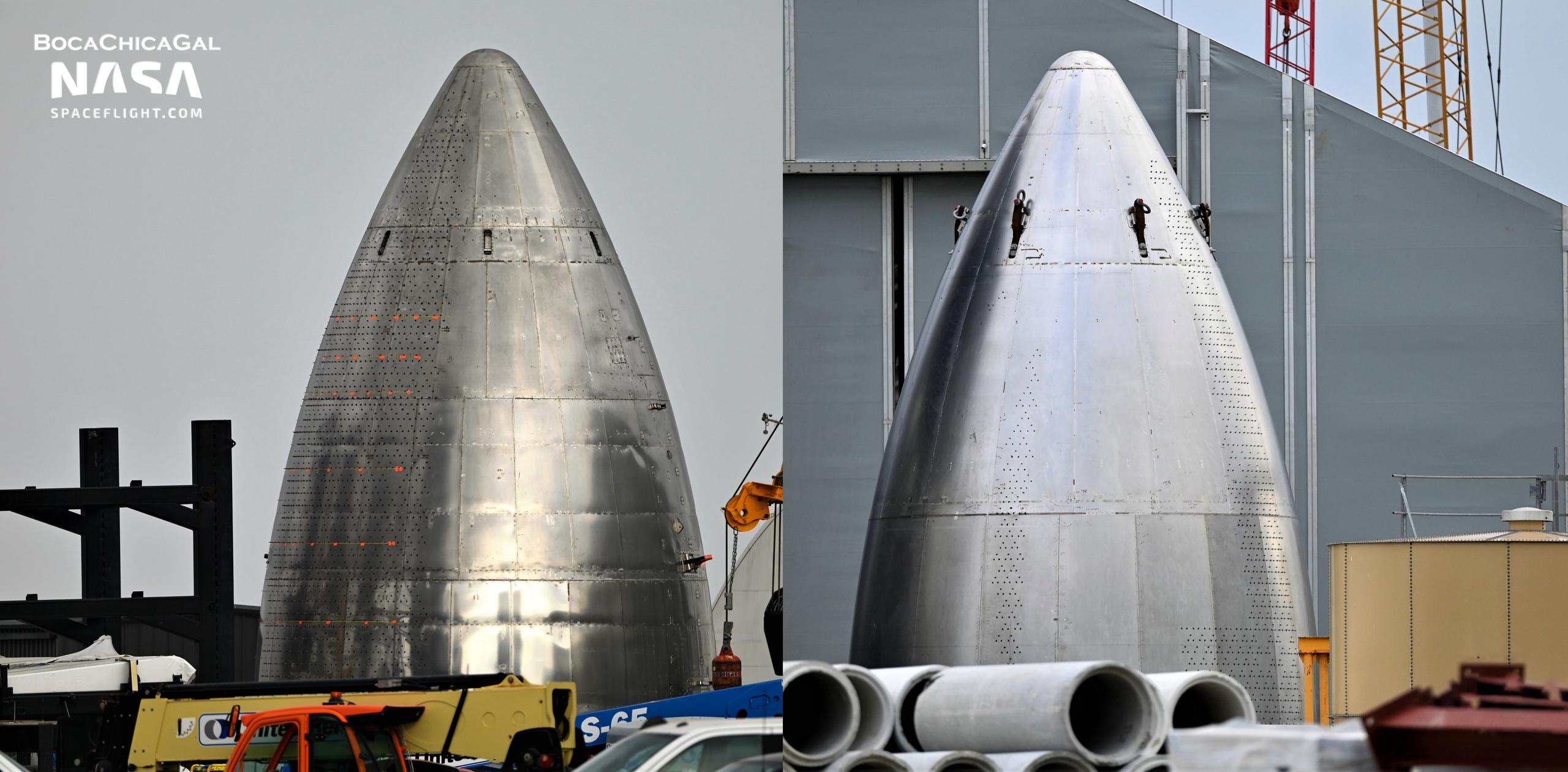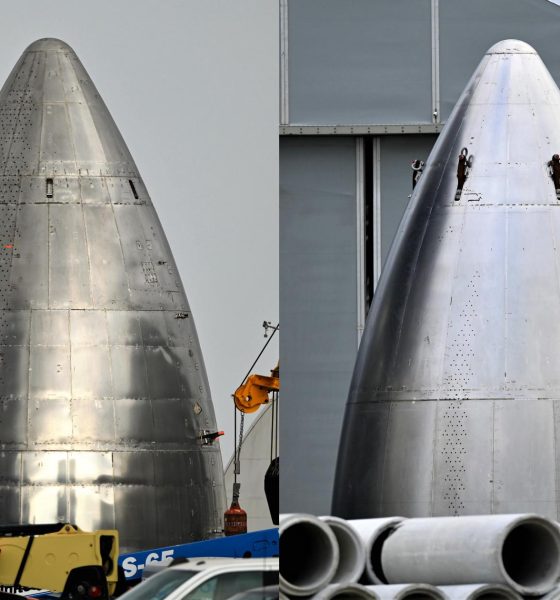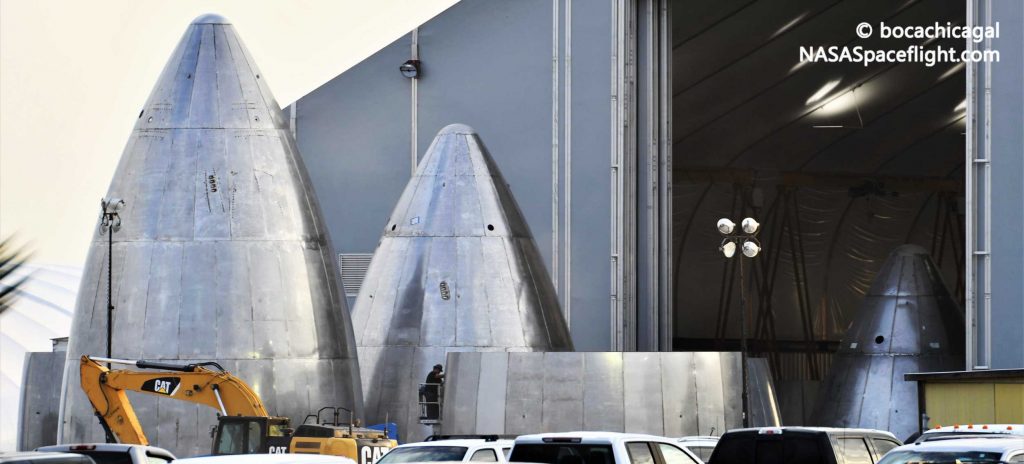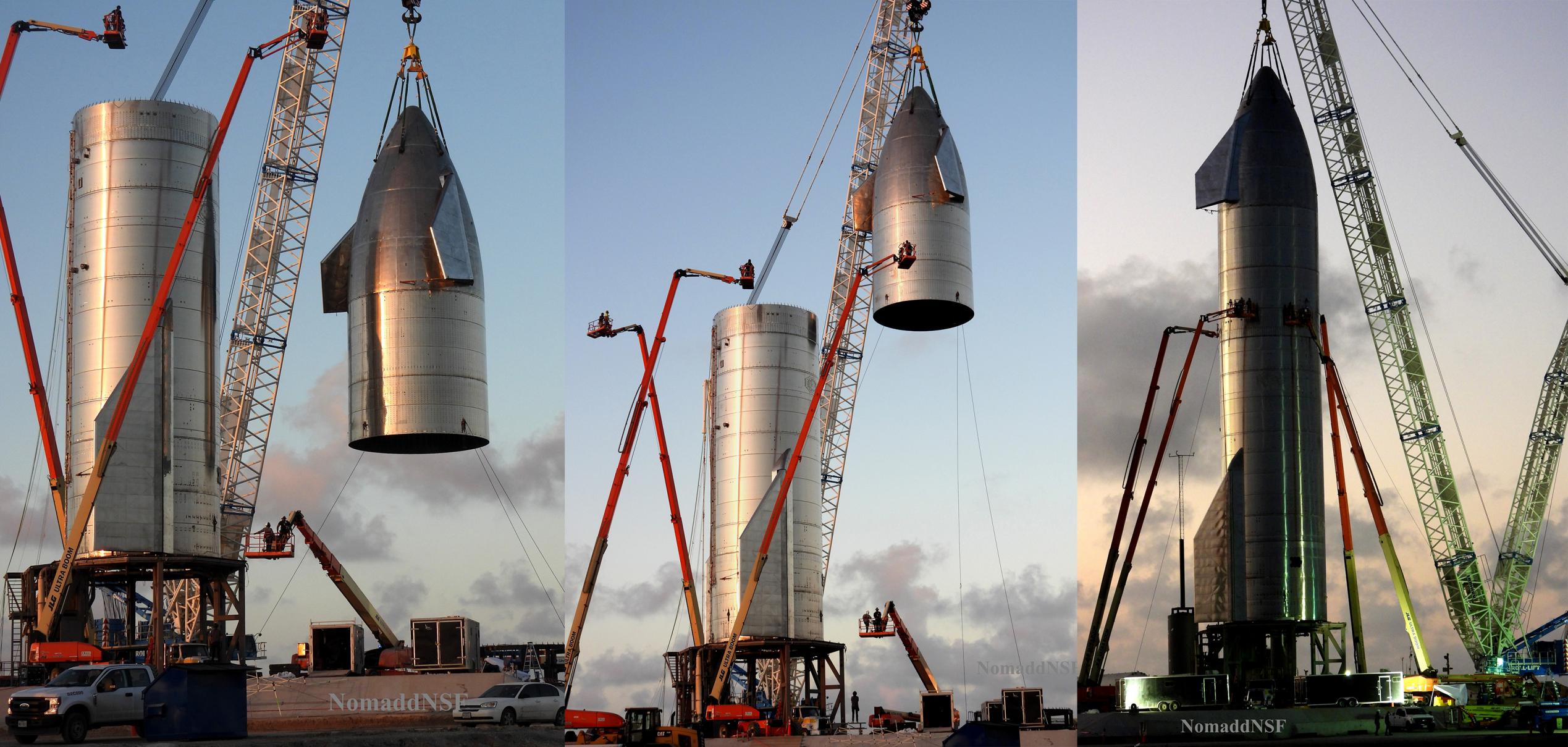

News
SpaceX upgrading Starship noses and domes for easier assembly
While a separate team closes in on the completion of a new and improved Starship nosecone, SpaceX also appears to have begun assembling upgraded ‘tank domes’ that feature a similar underlying design change.
On the nose front, SpaceX has been working on a new and improved version of Starship’s nosecone for at least a year and assembling pathfinders and prototypes of varying fidelity since mid-2020 – around the same time when Starship SN15 became the first (and only) prototype to successfully launch and land. Further down the rocket, hints of Starship dome upgrades are a much more recent development.
Excluding Starship Mk1, which never had its far flimsier nose fully installed, the Starship nose design has been extremely consistent ever since SpaceX began building the first prototypes in mid-2020. Early prototypes were inevitably scrapped as SpaceX quickly iterated on the nose design and assembly process, culminating in Starship SN8, which became the first prototype to have its basic structure (tank section, nose, and flaps) fully assembled.



Though improvements and changes have almost certainly been made in the last ~18 months, the early unflown prototypes and the noses of Starships SN8, SN9, SN10, SN11, SN15, SN16, S20, and S22 have all been constructed in roughly the same way. SpaceX would first produce a series of thin, stamped sheets (gores) of steel. Once aligned on custom-built jigs, each of those gores would be welded together to form a slightly conical ring. Five total ‘rings’ would be assembled, each narrower and more conical than the last. The five sections would then be stacked one by one and welded together along their circumferences.

Altogether, something like 120 complex vertical welds would be needed just to assemble the most basic structure of a nose, followed by four or five no less complex circumferential welds to turn those sections into one cone. SpaceX’s upgraded design seeks to simplify that process mainly by increasing the size of the gores. Aside from modestly reducing the number of longitudinal sections needed to form the cone, SpaceX has also reduced the number of stacked sections from five to two, slashing the total number of gores needed by at least a factor of two or three. While not quite as substantial, the same simplification also reduces the length of vertical and circumferential welds needed to assemble a nosecone.


The spirit behind SpaceX’s new dome design appears to be very similar. Presumably doubling down on the stretch-forming production method developed for nosecone gores, SpaceX appears to have also decided to increase the size of dome gores and reduce the number of stacked sections required for dome assembly – albeit from three to two instead of five to two.
Collectively, this behavior is mostly predictable. With increasing confidence in the current design of Starship and Super Heavy, SpaceX now appears to be looking for ways to streamline and simplify manufacturing while simultaneously optimizing Starship’s design. Regardless of whether one is dealing with a highly advanced rocket factory or a smartphone assembly line, part count reduction is a very common and desirable way to reduce both cost and complexity. Additionally, drastically reducing the number of individual welds – and, to a slightly lesser degree, the total length of welds – required should also reduce the number of possible points of failure and the time needed for weld inspection and repair.
Having already scrapped a number of new nose pathfinders, it appears that Starship S24 will be the first to feature the new design. The process of stacking the ship has already begun. For domes, SpaceX appears to have only just begun assembling the first prototypes. If past dome changes are indicative of future behavior, one or several new ‘test tanks’ will likely be built to ensure that the new dome design performs as well as present-day hardware. It’s also unclear if SpaceX aims to replace all domes with a more spherical design or if, say, current Starship and Super Heavy thrust domes will remain the same for the time being.

Elon Musk
Elon Musk’s X will start using a Tesla-like software update strategy
The initiative seems designed to accelerate updates to the social media platform, while maintaining maximum transparency.

Elon Musk’s social media platform X will adopt a Tesla-esque approach to software updates for its algorithm.
The initiative seems designed to accelerate updates to the social media platform, while maintaining maximum transparency.
X’s updates to its updates
As per Musk in a post on X, the social media company will be making a new algorithm to determine what organic and advertising posts are recommended to users. These updates would then be repeated every four weeks.
“We will make the new 𝕏 algorithm, including all code used to determine what organic and advertising posts are recommended to users, open source in 7 days. This will be repeated every 4 weeks, with comprehensive developer notes, to help you understand what changed,” Musk wrote in his post.
The initiative somewhat mirrors Tesla’s over-the-air update model, where vehicle software is regularly refined and pushed to users with detailed release notes. This should allow users to better understand the details of X’s every update and foster a healthy feedback loop for the social media platform.
xAI and X
X, formerly Twitter, has been acquired by Elon Musk’s artificial intelligence startup, xAI last year. Since then, xAI has seen a rapid rise in valuation. Following the company’s the company’s upsized $20 billion Series E funding round, estimates now suggest that xAI is worth tens about $230 to $235 billion. That’s several times larger than Tesla when Elon Musk received his controversial 2018 CEO Performance Award.
As per xAI, the Series E funding round attracted a diverse group of investors, including Valor Equity Partners, Stepstone Group, Fidelity Management & Research Company, Qatar Investment Authority, MGX, and Baron Capital Group, among others. Strategic partners NVIDIA and Cisco Investments also continued support for building the world’s largest GPU clusters.
News
Tesla FSD Supervised wins MotorTrend’s Best Driver Assistance Award
The decision marks a notable reversal for the publication from prior years, with judges citing major real-world improvements that pushed Tesla’s latest FSD software ahead of every competing ADAS system.

Tesla’s Full Self-Driving (Supervised) system has been named the best driver-assistance technology on the market, earning top honors at the 2026 MotorTrend Best Tech Awards.
The decision marks a notable reversal for the publication from prior years, with judges citing major real-world improvements that pushed Tesla’s latest FSD software ahead of every competing ADAS system. And it wasn’t even close.
MotorTrend reverses course
MotorTrend awarded Tesla FSD (Supervised) its 2026 Best Tech Driver Assistance title after extensive testing of the latest v14 software. The publication acknowledged that it had previously criticized earlier versions of FSD for erratic behavior and near-miss incidents, ultimately favoring rivals such as GM’s Super Cruise in earlier evaluations.
According to MotorTrend, the newest iteration of FSD resolved many of those shortcomings. Testers said v14 showed far smoother behavior in complex urban scenarios, including unprotected left turns, traffic circles, emergency vehicles, and dense city streets. While the system still requires constant driver supervision, judges concluded that no other advanced driver-assistance system currently matches its breadth of capability.
Unlike rival systems that rely on combinations of cameras, radar, lidar, and mapped highways, Tesla’s FSD operates using a camera-only approach and is capable of driving on city streets, rural roads, and freeways. MotorTrend stated that pure utility, the ability to handle nearly all road types, ultimately separated FSD from competitors like Ford BlueCruise, GM Super Cruise, and BMW’s Highway Assistant.
High cost and high capability
MotorTrend also addressed FSD’s pricing, which remains significantly higher than rival systems. Tesla currently charges $8,000 for a one-time purchase or $99 per month for a subscription, compared with far lower upfront and subscription costs from other automakers. The publication noted that the premium is justified given FSD’s unmatched scope and continuous software evolution.
Safety remained a central focus of the evaluation. While testers reported collision-free operation over thousands of miles, they noted ongoing concerns around FSD’s configurable driving modes, including options that allow aggressive driving and speeds beyond posted limits. MotorTrend emphasized that, like all Level 2 systems, FSD still depends on a fully attentive human driver at all times.
Despite those caveats, the publication concluded that Tesla’s rapid software progress fundamentally reshaped the competitive landscape. For drivers seeking the most capable hands-on driver-assistance system available today, MotorTrend concluded Tesla FSD (Supervised) now stands alone at the top.
News
Elon Musk’s Grokipedia surges to 5.6M articles, almost 79% of English Wikipedia
The explosive growth marks a major milestone for the AI-powered online encyclopedia, which was launched by Elon Musk’s xAI just months ago.

Elon Musk’s Grokipedia has grown to an impressive 5,615,201 articles as of today, closing in on 79% of the English Wikipedia’s current total of 7,119,376 articles.
The explosive growth marks a major milestone for the AI-powered online encyclopedia, which was launched by Elon Musk’s xAI just months ago. Needless to say, it would only be a matter of time before Grokipedia exceeds English Wikipedia in sheer volume.
Grokipedia’s rapid growth
xAI’s vision for Grokipedia emphasizes neutrality, while Grok’s reasoning capabilities allow for fast drafting and fact-checking. When Elon Musk announced the initiative in late September 2025, he noted that Grokipedia would be an improvement to Wikipedia because it would be designed to avoid bias.
At the time, Musk noted that Grokipedia “is a necessary step towards the xAI goal of understanding the Universe.”
Grokipedia was launched in late October, and while xAI was careful to list it only as Version 0.1 at the time, the online encyclopedia immediately earned praise. Wikipedia co-founder Larry Sanger highlighted the project’s innovative approach, noting how it leverages AI to fill knowledge gaps and enable rapid updates. Netizens also observed how Grokipedia tends to present articles in a more objective manner compared to Wikipedia, which is edited by humans.
Elon Musk’s ambitious plans
With 5,615,201 total articles, Grokipedia has now grown to almost 79% of English Wikipedia’s article base. This is incredibly quick, though Grokipedia remains text-only for now. xAI, for its part, has now updated the online encyclopedia’s iteration to v0.2.
Elon Musk has shared bold ideas for Grokipedia, including sending a record of the entire knowledge base to space as part of xAI’s mission to preserve and expand human understanding. At some point, Musk stated that Grokipedia will be renamed to Encyclopedia Galactica, and it will be sent to the cosmos.
“When Grokipedia is good enough (long way to go), we will change the name to Encyclopedia Galactica. It will be an open source distillation of all knowledge, including audio, images and video. Join xAI to help build the sci-fi version of the Library of Alexandria!” Musk wrote, adding in a later post that “Copies will be etched in stone and sent to the Moon, Mars and beyond. This time, it will not be lost.”








